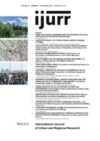This article will explore the geographical origins of Residential Mortgage Backed Securitization (RMBS) in the United States and map the subsequent migration of RMBS, as idea, technology and investment vehicle, to the United Kingdom and other nation‐states during the 1990s. It will illustrate how RMBS was used as a medium to circulate capital and construct urban space, and seek to interpret the development of RMBS and the contemporary credit crisis in the UK through a series of historical, political and sociological lenses. It argues that, despite travelling across the globe, this financial innovation has maintained a spatial sensitivity since the idea of securitization has been embodied and (re)interpreted in specific spaces to comply with local economic, political and social institutions. It also argues that this is an important primer to understanding the ‘credit crunch’ of 2007 and its repercussions. The article focuses particularly on how the current significance of securitization and RMBS can be traced back to the ‘Big Bang’ and the wider processes of the competitive re‐regulation of the City of London and the British financial system more generally during the mid‐1980s. It shows the differential evolution of securitization in the UK and US, and in so doing argues that such spatial variations have left different financial institutions in the two economies exposed to different forms of credit and market risk.
Details
Written by:
THOMAS WAINWRIGHT
Digital Object Identifier (DOI)
10.1111/j.1468-2427.2009.00876.x
About DOI
Read full article as PDF
Read full article as HTML
See the references for this article
